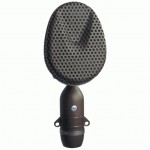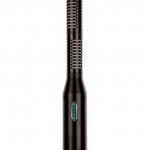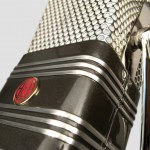Studio Toolbox: The Best Ribbon Mics In The World
As digital recording has become the norm, many tools that engineers once took for granted have disappeared from recording studios. But it’s one of the ironies of the DAW-age that the embrace of computer recording has led directly to the comeback of one technology that’s even older than tape itself. Today, we’re talking about the triumphant return of the pressure-gradient ribbon microphone.
Below are my personal picks for the three contemporary classics against which all other ribbon microphones can be judged.
Coles 4038
The Coles 4038 isn’t just one of the best ribbon microphones you can get for under $1,500 – it may also be one of the best microphones ever devised. In my book of vintage studio staples, the Coles 4038 would sit right up there alongside the most iconic designs from Neumann and AKG.
Unlike most of its condenser cousins, the Coles 4038 has remained completely unchanged for almost 40 years. The mic’s true legacy goes even further back than that, in fact, and buying a new one today is a whole lot like picking up an original off of the BBC’s private production line back in 1955.
The 4038’s smooth, natural, and textured sound makes it a beautiful performer on drums, strings, room and piano. It’s also a knockout on a good-sounding electric guitar amp, and it can even work well on vocalists who could use a little softening around the edges.
The top-end on this microphone rolls off sooner than many modern ears would expect, but that’s half of its charm. While the 4038 is not a natural choice for sounds that need to cut through a mix, it’s famous for taking EQ well, and a high-frequency boost in the right place can make the mic shimmer like satin does.
Still, don’t let the 4038’s balanced, gauzy timbre fool you: In the right scenario, this microphone rocks as hard as anything.
Royer SF Series
The Royer R-121 is about as far as a ribbon mic can get from the Coles 4038. On horns or electric guitars, it’s got balls, body, and bite all at once, and it’ll make your Shure SM57 sound razor-blade thin by comparison.
The R-121 may also be one of the best-marketed ribbon mics of the modern era, and it’s secured its place in the audio zeitgeist no matter what I have to say about.
Although I like the 121, I don’t believe it’s the magic bullet it’s been made out to be. I reserve that designation for another series of Royer ribbon mics that I believe stands shoulder-to-shoulder with the best in the world.
Royer’s mono SF-1 microphone is now discontinued, but when it came out it was probably the best ribbon mic to hit the market since the Coles 4038. It even outperforms that old classic in some ways: the SF series handles hotter SPLs without breaking up, it rolls off less significantly in the high-frequencies, and it can sound slightly more controlled in the bottom end. All this comes in what’s a remarkably small package compared to the Coles.
At the moment, the SF is only available in fixed-stereo configurations, where it excels as both a room and a remote-recording microphone, especially for classical and jazz. In fact, if you can get one stereo SF-12 or SF-24 in a good-sounding space with a great ensemble, you might not even need another mic.
Although it was never marketed as well as the rest of their line, the mono SF-1 can be extremely useful, and it’s still one of my favorites for horns and clean guitar – especially on jazz recordings. Luckily for you, enough opinionated loudmouths like me have complained that Royer has finally decided to release a mono version of the SF series once again. Look out for the phantom-powered SF-2 later this year.
Beyerdynamic M 160
If you’ve never recorded drums with a pair of Beyer M 160s, you just haven’t lived. It’s remarkable that any microphone can deliver so much muscle, especially as an XY pair out in the room.
The M 160 also works surprisingly well in an overhead configuration, or even as a close mic on snare. This hypercardiod ribbon mic has an uncanny ability to highlight both the crack and the mass of a snare drum, while providing a welcome softening effect on cymbals that can help tame the grating edge of an over-eager bronze-basher.
I’m not a huge fan of the M 160 on guitars, but plenty of people are. (Just ask Eddie Kramer and Jimi Hendrix). In addition to drums and rooms, the 160 can be great on trumpets, trombones, and as the center of a Mid-Side stereo setup.
For a ribbon mic with all the quality and a little less attitude, the Beyer M 130 is a great sleeper ribbon. It’s more neutral than the 160, can be fantastic on strings and horns and it makes a beautiful “side” mic in an MS stereo pair.
Like the Coles, these Beyer mics haven’t changed much over the years. They also remain one of the most affordable of the pedigreed ribbon breeds.
Runner Up: AEA R44 and A440
Wes Dooley knows a thing or two about ribbon mics. He made his name as both the U.S. distributor for Coles and as one of the most-trusted ribbon mic repairmen in America. His own company, AEA, now makes ribbon mics based on the long-discontinued classics from RCA.
The famously pill-shaped RCA 77 is hard to replicate as microphones of that model are notorious for sounding so dissimilar to one another, especially with age. Where Dooley has done astonishingly well is with his modern remakes of the boxy-looking RCA 44. His R44 and A440 microphones are a startling approximation of the originals – maybe even an improvement – and a welcome addition to any studio’s color wheel.
The Rest
Any microphone roundup that aims for digestibility is sure to leave out more mics than it can include. Rest assured that there are now fantastic ribbon microphones available at every price point, from companies like Cascade, Samar, Audio-Technica and Golden Age Audio, just to name a few favorites.
But before exploring the growing field of ribbon mics both good and bad, it’s good sense to get familiar with the contemporary classics profiled here. No matter what new ribbon mics come out, it’s likely that these models will remain the ones to beat.
For an exhaustive overview of a full field of modern ribbon mics, see our friends at RecordingHacks.com and their nearly overwhelming “$60,000 Ribbon Mic Shootout”.
Please note: When you buy products through links on this page, we may earn an affiliate commission.










PostProductionsAudio
April 26, 2012 at 11:32 pm (13 years ago)1000% agreed on the Royer SF-1! two of my colleagues have them and i jump at the chance to use them whenever possible and appropriate.
how about add something in the article about the Coles 4038 being the same as the STC 4038? i’ve met several Brits over the years who refer to them by their previous name.
also, what about mentioning the Cloudlifter products, seeing as how they’re relevant to the article?
in any case, great writing as usual Justin!
TrustMeI'mAScientist
May 8, 2012 at 1:40 am (13 years ago)Good additions, thanks for that!
Diamondjim
May 8, 2012 at 8:39 pm (13 years ago)Don’t forget Roger Cloud’s remakes of the RCA 44. The JRS34 Active Ribbon, designed by the son of the original designer of the 44. Phenomal sounding.
I had Roger modify a Cascade Victor and upgrade it to the same ribbon and electronics as the JRS34, for a fraction of the cost of a new JRS34. The Victor was decent sounding before, but for a few hundred bucks the upgrade was well worth it.
Busta Speeker
May 9, 2014 at 2:57 pm (11 years ago)I dearly loved my Shure 330, also…that was a great mic on female vocals.